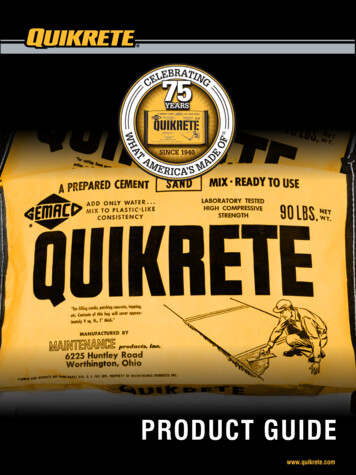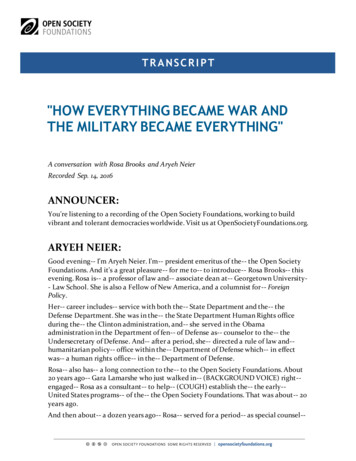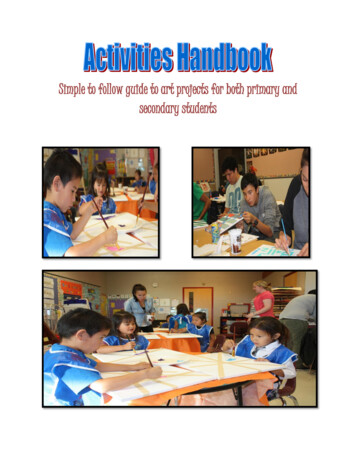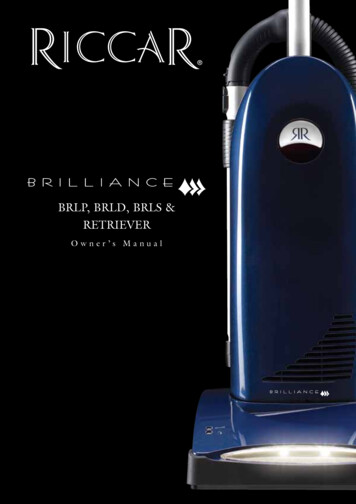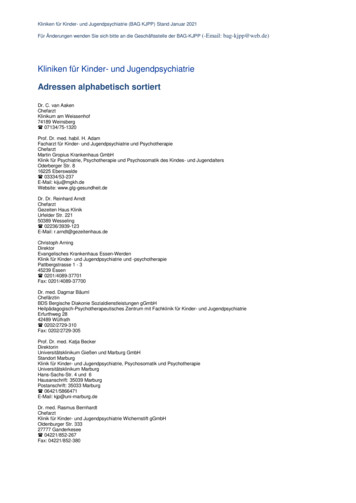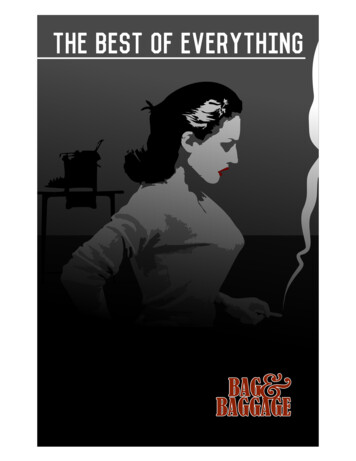
Transcription
THE BEST OF EVERYTHINGadapted by Julie Kramer, based on the book by Rona Jaffedirected by Michelle MilneSeptember 10-27, 2015STUDY GUIDE CONTENTSIntroductionBackgroud: Women and WorkWomen Writing, Adapting, DirectingTerms to KnowTimelineThemesQuestions and PromptsBAG&BAGGAGE STAFFScott PalmerArtistic DirectorBeth LewisManaging DirectorArianne JacquesPatron Services ManagerCassie GreerEngagement OfficerEmily TrimbleCompany Stage ManagerCASTCassie Greer* . Caroline BenderJessi Walters* . Mary Agnes RussoKaia Marja Hillier . April MorrisonMorgan Cox . Amanda FarrowArianne Jacques* . Gregg AdamsStephanie Kay Leppert . Brenda ZaleskiAndrew Beck* . Eddie HarrisJoey Copsey* . Mike RiceDavid Wilder SavageMr. ShalimarRonnie WoodCREW/PRODUCTION TEAMMichelle Milne . DirectorEmily Trimble† . Stage ManagerProps MistressEphriam Harnsberger . Assistant Stage ManagerMelissa Heller† . Costume DesignerMegan Wilkerson† . Scenic DesignerMolly Stowe† . Lighting DesignerScott Palmer . Sound DesignerMatthew Hays . Run Crew*Member of the Bag&Baggage Resident Acting Company†Member of Bag&Baggage Resident Production Team
INTRODUCTIONA still from the 1959 film “The Best of Everything”, based on a NewYork Times ad that inspired Rona Jaffe’s titleRona Jaffe was born in 1931 in Brooklyn, New York, and grew upin the affluent Upper East Side of Manhattan. Jaffe, a strugglingwriter, was temporarily jobless in the mid-1950s when she went tovisit a friend who was working as secretary to the editor-in-chiefat Simon & Schuster. The famous Hollywood producer Jerry Waldhappened to be in the room, and told her he was looking for a bookabout being young, female, and working in New York. Jaffe decidedshe was the perfect person to write this, and a year later, The Best ofEverything was born. Published in 1958, it was made into a moviethe following year, and was adapted for the stage by Julie Kramer in2012.The Best of Everything draws on Jaffe’s personal experiences, and the experiences of her friends, to tell the story of five youngfemale employees at the fictional Fabian Publishing Company in New York City. Over the course of two years, we follow thelives of Caroline, April, Gregg, Mary Agnes, and Brenda, as they navigate, work, life, men, marriage, heartbreak, friendship, andeverything in between.BACKGROUND: Women and Work in 1950s AmericaAmerica in the 1950s experienced a huge boom of suburbancommunities. World War II had ended in 1945, and alongwith men returning home, the United States Government hadpassed the GI Bill in 1944, benefitting war veterans with lowcost mortgages and enabling many young couples across thecountry to buy their own homes. The first mass-producedsuburb - Levittown, New York - was built in 1951, and wasrapidly followed by the creation of suburban neighborhoodsaround the country. These houses were built quickly and cheaply,resulting in uniformity of the design and “homogenous” suburbanneighborhoods.The decade after World War II also included a “baby boom,”where millions of Americans began having families. New formsof media - in particular, the television - promoted a consumerculture particularly geared towards families, with pressure to“keep up with the Joneses” with material purchases of items suchas cars and appliances. This new media also helped create the newsuburban ideal with the television show Leave it to Beaver: thewhite, nuclear family with specific gender roles.Television media also enabled America to fight a propaganda warin the face of the threat of Soviet Communism, which becameintrinsically tied to the ideal of the American Woman. Thehorrors of Communism were depicted in the lives of Russianwomen, shown dressed in gunnysacks as they toiled in drabfactories, while their children were placed in cold, anonymousday care centers. In contrast to the “evils” of Communism, theAmerican Woman was depicted with her feminine hairdo anddelicate dresses, tending to the hearth and home as she enjoyedthe fruits of capitalism, democracy, and freedom.An areal view of Levittown in the early 1950sA Metropolitan Life Insurance ad from 1947
In addition to the homemaker image, there was tremendous societal pressure on young women to focus their aspirations on awedding ring. The U.S. marriage rate was at an all-time high after World War II, and couples were tying the knot, on average,younger than ever before, with most women walking down the aisle at age 19. Although women may have had other goals inlife, the dominant theme promoted in the culture and media at the time was that a husband was far more important for a youngwoman than a college degree. If a woman wasn’t engaged or married by her early twenties, she was in danger of becoming an“old maid.”With the cultural emphasis on marriage and family, a majority of brides were pregnant within seven months of their wedding.Large families were typical, and from 1940 to 1960, the number of families with three children doubled and the number offamilies having a fourth child quadrupled. For single young women in American society, however, being pregnant was totallyunacceptable, especially for white women. Girls who “got in trouble” were forced to drop out of school, and often sent away todistant relatives or homes for wayward girls. Shunned by society for the duration of their pregnancy, unwed mothers paid a hugeprice for premarital sex.Housekeeping Monthly published “The Good Wife’s Guide” in one oftheir 1955 issues, offering the following tips: Have dinner ready. Plan ahead, even the night before to havea delicious meal ready, on time for his return. This is a way ofletting him know that you have been thinking about him and areconcerned about his needs. Most men are hungry when they comehome and the prospect of a good meal (especially his favourite dish)is part of the warm welcome needed. Prepare yourself. Take 15 minutes to rest so you’ll be refreshedwhen he arrives. Touch up your make-up, put a ribbon in your hairand be fresh-looking. He has just been with a lot of work-wearypeople. Listen to him. You may have a dozen important things to tell him,but the moment of his arrival is not the time. Let him talk first –remember his topics of conversation are more important that yours. Make the evening his. Never complain if he comes home late orgoes out to dinner, or other places of entertainment without you.Instead, try to understand his world of strain and pressure and hisvery real need to be at home and relax. Don’t complain if he’s late home for dinner or even if he stays out allnight. Count this as minor compared to what he might have gonethrough that day. Arrange his pillow and offer to take off his shoes. Speak in a low,soothing and pleasant voice. Don’t ask him questions about his actions or question his judgmentor integrity. Remember he is the master of the house and as suchwill always exercise his will with fairness and truthfulness. You haveno right to question him.A good wife always knows her place.
This was the era of the “happy homemaker,” where domesticity was idealized, and women were encouraged to stay at home ifthe family could afford it. Women who chose to work when they didn’t need the paycheck were often considered selfish, puttingthemselves before the needs of their family.While women may have been pretty, domestic, quiet, and happy on the surface, many were deeply discontented with this life.Betty Friedan, an early leader of the Women’s Rights movement of the 1960s and 70s, wrote The Feminine Mystique in 1963, inwhich she discussed how stifled and unsatisfied many suburban women were in the 1950s:“Each suburban wife struggles with it alone. As she made thebeds, shopped for groceries, matched slipcover material, atepeanut butter sandwiches with her children, chauffeured CubScouts and Brownies, lay beside her husband at night - she wasafraid to ask even of herself the silent question-- ‘Is this all?’”And indeed, within this happy, domestic framework, the seed wasbeing planted for a new female role in American society. The growthof consumerism, media, and suburban living had set the stage for theemergence of the two-income family: homes and cars, refrigeratorsand washing machines, telephones and multiple televisions requirehigher incomes, and women in the workplace was part of the answer.Because of labor shortages during World War II, more women had entered the workforce than ever before; in the post-warera many continued to work in spite of the national emphasis on domesticity and family, though jobs that were acceptablefor women became much more traditional. In 1950 women comprised 29% of the work force and as the decade went on thatnumber only increased. By the mid-50s, 70% of all employed women were working in clerical positions, on factory assemblylines or in the service industry; less than 15% of women were employed in a professional capacity; and the number of women inmanagement was even far less, topping out at 6%. Though there was little choice in available jobs, women often pursued work as they moved to the suburbs and filled their homes with the latest appliances - to allow their family to live in the manner theyfelt they deserved. Women who had the opportunity to pursue a post-secondary education were also more likely to enter theworkforce; these women were the most fortunate as they could demand higher salaries than their less educated counterparts.In The Best of Everything, we see Caroline, April, Gregg, Mary Agnes,and Brenda, all in their 20s, working as secretaries in the typing poolof a New York publishing company. While they are working girls,most aspire to the domestic ideal of 1950s American life, and menand marriages consume their thoughts and conversations. There isthe expectation that women find work only as a means to locating ahusband; the job itself is a secondary consideration. Miss Farrow, atthe age of 36, is the hardened “old maid,” and Caroline is constantlyquestioned for valuing her career over her potential future marriage.
WOMEN WRITING, ADAPTING, AND DIRECTING:Rona Jaffe, Julie Kramer, and Michelle MilneRona Jaffe, born in Brooklyn, New York in 1931, was the daughter of an elementaryschool principal and a socialite, and grew up privileged, unlike many of the charactersshe writes about in The Best of Everything. But similar to some of her characters Miss Farrow and Caroline in particular - Jaffe was professionally ambitious, and aftergraduating from the Dalton School and Radcliffe College by the age of 19, she becamea file clerk at Fawcett Publications and proceeded to work her way up to becomingan associate editor. Also like her characters, Jaffe had numerous romantic adventures,though she never married, preferring to avoid what she once dismissively described as“the rat race to the altar.”Much of The Best of Everything is based on Jaffe’s own experiences asa working girl in the publishing world, as well as on the experiencesof her college best friend Phyllis, who was the personal secretaryto the top editor at Simon & Schuster. Jaffe also interviewed fiftyworking women as she set out to write her book, mostly to comparenotes and question them about things that were normally notmentioned in polite company. “Back then,” Jaffe wrote in her forwardto the 2005 reissue of The Best of Everything, “people didn’t talk aboutnot being a virgin. They didn’t talk about going out with marriedmen. They didn’t talk about abortion. They didn’t talk about sexualharassment, which had no name in those days. But after interviewingthese women, I realized that all these issues were part of their livestoo.” All of these less-savory issues make an appearance in The Bestof Everything: it is frank about women’s newfound sexual freedom;it is honest about their ambitions; and in addressing these ideasunapologetically, The Best of Everything was considered racy andcontroversial upon its initial publication.Jaffe also questioned whether there is even such a thing as “the bestof everything” and, through her work, pointed out the great mythin the 1950s promise of “having it all”, far before many other writerswere able to articulate this idea. Though The Best of Everythingsometimes gets described as “superficial” and “empty”, it is, in fact,one of the first pro-feminist works to even ask whether managinga career and a romance were compatible. The Best of Everythingcontinues to have resonance with American culture today: thegender pay gap still exists, and women in positions of authorityin the workplace is still a topic of discussion, with the continuedprevalent idea that a woman must “be a b****” in order to advanceher career.“Secretary and Boss” from Lambert/Getty Images50s secretary pinup illustration by Gil ElvrenAfter publishing The Best of Everything in 1958, Jaffe went on to write cultural pieces for Cosmopolitan magazine during the1960s, and publish fifteen more novels between 1960 and 2003. Before her death in 2005, Jaffe established herself as a patronof the arts, founding the Rona Jaffe Foundation in 1995, which provides grants to emerging female writers. “All writers needsupport,” she is quoted as saying, “but many women in early career have fewer resources available to them and often manydemands made upon them. It gives me great pleasure to help some of them make their way at this early stage.”
Julie Kramer is a New York-based, critically-acclaimed theatre director,known for her work developing new plays and musicals. Her 2012 adaptationof The Best of Everything was named a “Critics Pick” by The New YorkTimes and one of the Best Plays of the Year in The Huffington Post. Kramerdeveloped The Best of Everything with longtime friend, collaborator, andfellow New York theatre artist Amy Wilson, with whom she has workedsince their speech and debate days at Scranton Central High School inPennsylvania. Kramer directed Wilson’s acclaimed one-woman show MotherLoad, and Wilson appeared as Miss Farrow in the premiere of The Best ofEverything.Kramer was initially drawn to The Best of Everything for its wealth of complicated and strong femalecharacters, as well as the themes of women, work, and sex that are still prevalent in 21st CenturyAmerica. “The pressures to get married and have kids, it felt relevant to me,” she said in a 2012interview. “You have all these stories lately why women still can’t have it all. It’s interesting that it’ssomething we’re still trying to figure out.”The stage version of The Best of Everything was developed through a process of workshops andreadings, as is typical with a piece of theatre, as Kramer worked to create scenes that sometimesweren’t completely depicted in Jaffe’s book, and distill the story down to its most poignant bits.Kramer talked about needing to “get inside the head of Rona Jaffe, and think, what would theydo here, what would they say here?” in her process of fleshing out characters and scenes. Wilsoncommented, about her friend and collaborator, that “[Julie has] adapted an amazing script from abook that is great, too, but sprawling in its narrative. [She’s] really sharpened it and cut it down toits most insightful narrative, and that’s always what’s been her strength as a director as well.”Michelle Milne directs Bag&Baggage’s production of The Bestof Everything, and she herself comes from a background ofdirecting, adapting, and writing for the theatre. Mline teachesacting, playwrighting, voice, and movement classes in the theatredepartments of Columbia College Chicago and Goshen College,and is currently traveling around the country for the second time inthree years as part of an ongoing writing project; her work here withBag&Baggage is one of the stops along her way.Milne specializes in directing original, ensemble-created performances of both contemporary andclassical texts, and facilitates performances that aim to engage the audience physically and visually,with immediacy and bravery. She comes to The Best of Everything with an apprecation for thebubbling life below the pristine surface of 1950s America:When we think of the 1950s, we may think of cookie-cutter women and men, withdesignated roles played out in cookie-cutter offices and homes, bringing order to society.And yet - one thing I love about this play is that the sheen cracks, the typing is interrupted,and real lives emerge. Each page turns out to hold a unique story. And those stories aremessy - just as messy as our lives are. Rona Jaffe found in her interviews with office womenof the time that they had affairs, abortions, anxiety about being old maids - in short, shefound that they were complex people, living complex lives. That, to me, is a relief. Whenwhat we see are postcard-perfect images of another era, we forget that real human beingslived in that era. Our culture encourages us to make people (particularly women)interchangeable. The Best of Everything reminds us that they (and we) are not.
TERMS TO KNOWtyping pool: a group of secretaries working at a company available to assistany executive without a permanently assigned secretary. After the widespreadadoption of the typewriter but before the photocopier and personal computer,pools of typists were needed by large companies to produce documents fromhandwritten manuscripts, re-type documents that had been edited, typedocuments from audio recordings, or to type copies of documents.The typing pool at the Mattel offices in New York City in1956temp: slang for “temporary worker” - a situation where the employee isexpected to leave the employer within a certain period of time. Temporaryworkers may work full-time or part-time, depending on the individual case.A temporary work agency, temp agency or temporary staffing firm finds andretains workers; other companies, in need of short-term workers, contractwith the temporary work agency to send temporary workers, or temps, onassignments to work at the other companies. The staffing industry in theUnited States began after World War II with small agencies in urban areasemploying housewives for part-time work as office workers. Over the yearsthe advantages of having workers who could be hired and fired on shortnotice and were exempt from paperwork and regulatory requirementsresulted in a gradual but substantial increase in the use of temporary workers,with over 3.5 million temporary workers employed in the United States by2000.Third Avenue bars: Third Avenue is located in the Bowery, a neighborhood in the southern portion of the New York Cityborough of Manhattan. The Bowery went from premier entertainment district in the 1800s, to a skid row of cheap theaters,flophouses, and eponymous bums by the middle of the 20th century. Third Avenue bars in the 1950s would have been among themost disreputable in the city.Vassar: Vassar College is a private liberal arts college in the town of Poughkeepsie, New York. Founded as a women’s college in1861 by Matthew Vassar, the school became a co-ed institution in 1969, and has a reputation for being both progressive, as wellas populated mainly by children from wealthy upper-middle class families.Radcliffe: Radcliffe College was a women’s liberal arts collegein Cambridge, Massachusetts, and functioned as a femalecoordinate institution for the all-male Harvard College. Ithad popular reputation of having a particularly intellectualand independent-minded student body. On October 1, 1999,Radcliffe College was fully absorbed into Harvard University;female undergraduates were henceforward members onlyof Harvard College while Radcliffe College evolved into theRadcliffe Institute for Advanced Study.Unveiled, The Cross, America’s Woman - fictitious magazines- entertainment, religious, and homemaking - that arereferenced in The Best of EverythingLouella Parsons: the first American gossip and moviecolumnist, who began writing for the Chicago Record Heraldin 1914, and subsequently moved on to the New York MorningTelegraph.A 1951 ad for Lucky Lane Trousseau Chests
trousseau: an assortment of items such as clothing and household linnen that were collected in a chest by an unmarried youngwoman in anticipation of married life. Building up a trousseau was a common coming-of-age rite until approximately the 1950s,and was the working girl’s equivalent of an ambitious young man planning and saving for marriage; it was typically a step on theroad to marriage between courting a man and engagement. “Trousseau” can also refer to the chest itself in which these itemswere stored.Gimbels: an American department store corporation from 1887 until 1987. The company is known for creating the GimbelsThanksgiving Day Parade, the oldest parade in the country; Gimbels was also once the largest department store chain in thecountry. The Gimbels New York flagship store was located in the cluster of large department stores that surrounded HeraldSquare, in Midtown Manhattan, New York City.garter-snapper: a term used popularly in the 1920s-1950s that refers to a man who has sex with many different women or hasa lot of one night stands. The term originates in this time period due to the fact that women often wore garters to hold up theirtights and therefore someone who often “snaps” these garters takes them off.Automat: a precursor to modern fast food, an automat is arestaurant where simple foods and drink are served by vendingmachines.Sardi’s: a historic, classy restaurant located in the Theater District inManhattan, in New York City. Known for the hundreds of caricaturesof show-business celebrities that adorn its walls, Sardi’s opened at itscurrent location on March 5, 1927.A busy New York City automat in 1942.Image from the National Geographic Archives.Greenwich Village: a neighborhood on the west side of LowerManhattan, New York City, known as the Bohemian capital and theEast Coast birthplace of the counterculture movements that shapedthe latter half of the 20th century. “The Village”, as it’s commonlyreferred to, saw a huge influx of writers, poets, artists, and studentsduring the 1950s, all fleeing from what they saw as oppressive socialconformity, and creating their own looser and more liberal culture.Saks: Saks Fifth Avenue is an American department storechain, incorporated in 1902 as Saks & Company, whoseflagship store and corporate headquarters are located inMidtown Manhattan, New York City. Saks quickly gained areputation as one of the more luxurious department stores,and its legacy and promise of luxury and style lives on today.The Barberry Room: referrs to The Barberry Room of theBerkshire Hotel, which originally opened as “the ElbowRoom” in April 1938. When it opened, the Elbow Room wasone of the most elegant and exclusive private clubs in NewYork, and continued to be so even after its name change. Theroom featured mirrors on facing walls to reflect the imagesof patrons, and was a particular favorite with theatrical andtelevision people, many from CBS headquarters across thestreet on Madison Avenue.The Barberry Room’s main dining room, photographed c. 1937
TIMELINEThe events in The Best of Everything span the course of two years, with scenes sometimes jumping forward in time by a week,sometimes by a year. The timeline below provides a rough layout of the action:THEMESRhythmThe rhythms of an office in a city, contrasting with the rhythms of relationships,or of a ship (a dream?) sailing away. How do we navigate the rhythms of work andlove? Do we walk on prescribed paths, making sharp turns, following expectations?Or do we look for something different, winding around and through the areas outside of expectations?AmbitionMike Rice tells Caroline she’s “damn smart,” then warns her to “be careful whoknows it.” “And here I thought that was a compliment,” she says. How do we feelabout ambition? What does “being ambitious” look like? And how does the genderof someone who is “ambitious” play into our feelings about whether or not ambition is a strength or a character fault? Caroline is described as ambitious at work,while other characters could be described as ambitious in love. What happens whensomeone tries to be ambitious in both love and work? Is it possible, really, to achievethe best of everything?InterchangeabilityIn our production, desks and other objects are interchangeable, so it doesn’t matterwhere someone sits or which typewriter is used. Secretaries are interchangeable, soit doesn’t matter who does the work - or which one the boss decides to kiss. Booksare interchangeable, so people buy them for the titles and don’t care what they say.Even the men are interchangeable. One turns into another, and another, each serving a role and then disappearing, at least for a while. We might think, at the start ofthe play, that the women are interchangeable as well. Eddie exchanges one womanfor another. The women in the typing pool all appear almost identical at first glance.
QUESTIONS AND PROMPTS1. Caroline is constantly referred to as “ambitious” by other characters in the play.a. Do you agree that she’s ambitious? What is it that makes her come across this way?b. How are our modern notions of “ambition” similar to or different from the notions that are displayed in The Best ofEverything?2. “I wonder if you could have Miss Farrow’s life without being mean like Miss Farrow?” April muses to Caroline at one point.Do you think being a woman in a successful executive career without being mean and hardened would have been possible in the1950s? What about today?3. Julie Kramer notes in the script that “this is a story about the girls in the typing pool, not the men in the offices, so most of themale characters are played by one actor. Only Eddie is played by a separate actor, because to Caroline, he’s not like all the others.Whether she’s right about that or not remains to be seen.”a. Do you think Eddie is just like all the other men or not?b. What is the effect on the audience of having one actor play four characters when all the other actors are playing singlecharacters?4. The title of the play comes from an actual ad that Rona Jaffe saw in the New York Times: a job listing that promised job‐seekingsecretaries “the best of everything.” Julie Kramer uses the line at the beginning of the play, as Eddie wishes Caroline “the best ofeverything” upon their breakup. Discuss how both Jaffe and Kramer use the phrase ironically.5. Rona Jaffe mentions in her 2005 notes on The Best of Everything that sexual harassment had no real name in the 1950s. Fromwhat you know about the time period, what do you think made men believe that this kind of behavior was acceptable? Whatabout this has changed, and what has stayed the same?6. Each female character in The Best of Everything has a distinct arc - a journey that she goes on. Describe the arc of eachcharacter, and discuss their similarities and differences.SOURCES AND FURTHER READINGRead blog posts from the cast and crew at http://bagnbaggage.org/category/blog-bloggage/Rona Jaffe’s Web Site: http://ronajaffe.com/Richard Gorey’s lecture notes on The Best of Everything: http://www.joancrawfordbest.com/goreyboe.htmThe Book Snob blog: t-of-everything-by-rona-jaffe/HuffPost review: st-of-everything b 1959346.htmlNew York Times review: html? r 1Robert Gottlieb’s New Yorker piece: efore-girls#entry-moreThe Times-Tribune preview: hing-adaptation-1.1378055#.UGIMgTCzwYw.facebookThe Guardian book reviews: everything-rona-jaffe-reviewand: everything-rona-jaffe-reviewWomen in 1950s America: http://bookbuilder.cast.org/view print.php?book 42401The Guardian on secretaries: 5/secretaries-servant-canny-career-moveCNN Money on secretaries: tary-women-jobs/index.html1950s Opportunities for Women from Edith Hornbook Beer Digital Scrapbook: http://alanis.simmons.edu/edith/opportunitiesNotes on the American Experience documentary, “The Pill”: http://www.pbs.org/wgbh/amex/pill/peopleevents/p mrs.htmlAmerican Memory of the 1950s Housewife: paces.net/StereotypesHuffPost Live secretary discussion: or-women-is-secretary/510eb06e2b8c2a13850006ea
Everything was born. Published in 1958, it was made into a movie the following year, and was adapted for the stage by Julie Kramer in 2012. BACKGROUND: Women and Work in 1950s America A still from the 1959 film “The Best of Everything”, base
